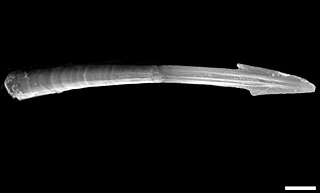
Helix is a genus of large, air-breathing land snails native to the western Palaearctic and characterized by a globular shell.

Limacus flavus, known commonly as the cellar slug, the yellow slug, or the tawny garden slug, is a medium to large species of air-breathing land slug, a terrestrial pulmonate gastropod mollusk in the family Limacidae.

Cornu aspersum, known by the common name garden snail, is a species of land snail in the family Helicidae, which includes some of the most familiar land snails. Of all terrestrial molluscs, this species may well be the most widely known. It was classified under the name Helix aspersa for over two centuries, but the prevailing classification now places it in the genus Cornu.

Helicidae is a large, diverse family of western Palaearctic, medium to large-sized, air-breathing land snails, sometimes called the "typical snails." It includes some of the largest European land snails, several species are common in anthropogenic habitats, and some became invasive on other continents. A number of species in this family are valued as food items, including Cornu aspersum the brown or garden snail, and Helix pomatia. The biologies of these two species in particular have been thoroughly studied and documented.

Limax cinereoniger, the ash-black slug is a large species of air-breathing land slug in the terrestrial pulmonate gastropod mollusc family Limacidae, the keelback slugs. This is the largest land slug species in the world.

Athoracophorus bitentaculatus, is a species of land slug, a terrestrial gastropod mollusc in the family Athoracophoridae.

A love dart is a sharp, calcareous or chitinous dart which some hermaphroditic land snails and slugs create. Love darts are both formed and stored internally in a dart sac. These darts are made in sexually mature animals only, and are used as part of the sequence of events during courtship, before actual mating takes place. Darts are quite large compared to the size of the animal: in the case of the semi-slug genus Parmarion, the length of a dart can be up to one fifth that of the semi-slug's foot.

Mermithidae is a family of nematode worms that are endoparasites in arthropods. As early as 1877, Mermithidae was listed as one of nine subdivisions of the Nematoidea. Mermithidae are confused with the horsehair worms of the phylum Nematomorpha that have a similar life history and appearance.
Agfa flexilis is a species of parasitic nematodes.
Angiostoma is a genus of parasitic nematodes in the family Angiostomatidae.

Pterygodermatites is a genus of parasitic nematodes in the family Rictulariidae. Their life-cycle is complex. Species include:

Sphaerotheriida is an order of millipedes in the infraclass Pentazonia, sometimes known as giant pill millipedes. They inhabit Southern Africa, Madagascar, South and Southeast Asia, Australia and New Zealand. Like the Northern Hemisphere pill millipedes of the order Glomerida, these millipedes can roll into a ball when disturbed. When they are rolled-up, most sphaerotheriidans reach a maximum size of a cherry or golf ball, but some species from Madagascar can even reach the size of an orange. When rolled-up, predators are unable to unravel giant pill millipedes since the margins of their second and last dorsal plates fit perfectly into one another, creating a sealed ball. A few giant pill millipede species are able to produce sound, the only millipedes known to do this. This order of millipedes is also unique in that some African species are used for medicinal purposes.

Huffmanela is a genus of parasitic nematodes, belonging to the family Trichosomoididae.
Aplectana is a genus of nematodes. It includes, among other species, Aplectana herediaensis.

Harrison's rule is an observation in evolutionary biology by Launcelot Harrison which states that in comparisons across closely related species, host and parasite body sizes tend to covary positively.

František Moravec is a Czech parasitologist who specialises on the Nematodes, especially the nematodes parasites of fishes. His research is mainly in the field of taxonomy of the Nematoda.

Cystidicolidae is a family of spirurian nematodes. It was described by Skrjabin in 1946. All members of the family are parasites of fish.

Moravecnema is a genus of parasitic nematodes, belonging to the family Cystidicolidae. Species of Moravecnema are parasitic as adults in the gastrointestinal tract of fish. According to the World Register of Marine Species, the genus currently (2019) includes a single species, Moravecnema segonzaci, which is a parasite in a deep-sea fish.
Syncuaria is a genus of parasites in the family Acuariidae, first described in 1927. They are usually found in the gizzard lining of the aquatic birds that they parasitize which belong to Pelecaniformes, Ciconiiformes and Podicipediformes. The genus is characterized by, among other things, cordons on the bodies lateral sides that are linked by anastomosis, and monodelphy. Synonyms include: Skrjabinocara (Kurashvili), Chordocephalus (Alegret), and Decorataria (Sobolev).












